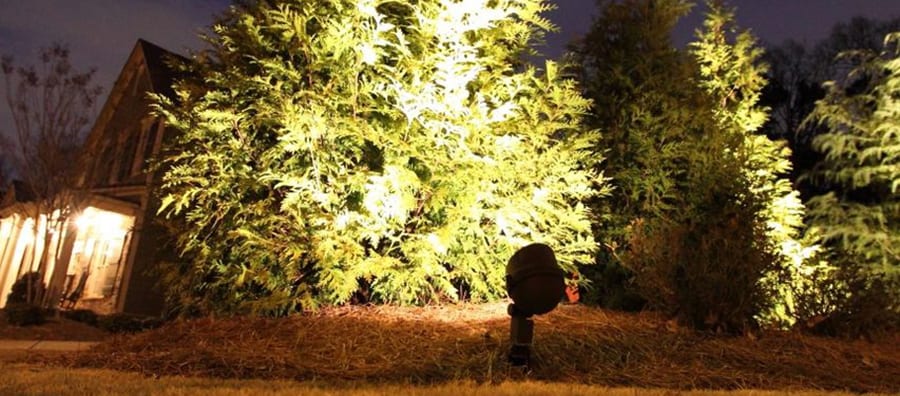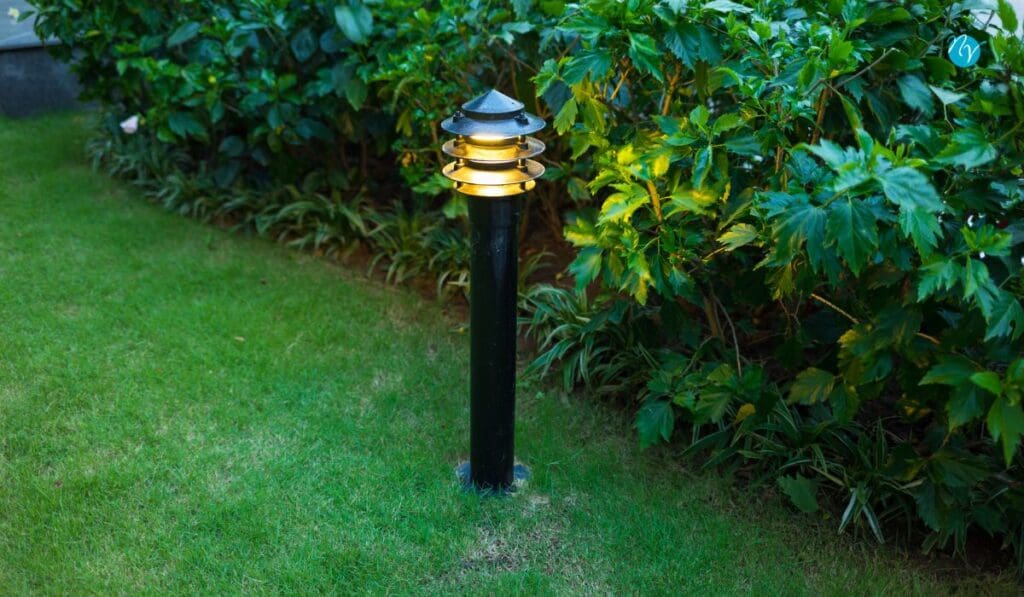Outdoor and landscape lighting done right can really bring your home to life after dark.
Most Atlanta homes come with a simple porch light to illuminate the front door. But that leaves the rest of the house in total darkness, completely obscuring your beautiful home and surrounding gardens.
Some homeowners may install path lighting along a front walkway. This may help with visibility and safety as you approach the house, but if aren’t also thinking about outdoor lighting design your path lighting will likely do little for the curb appeal of your home.
Using The Right Light For The Right Job
Not all bulbs and fixtures are created equal. To design an appealing outdoor lighting scheme, you need to know about the various options available. A wide variety of bulbs and fixtures can provide different types of light for different effects. Some lighting is best for trees, while other lighting is best to illuminate the facade of your home.
Of course, the simplest path to excellent outdoor lighting design is to bring in a pro. The experts at NightVision Outdoor Lighting can help you design the perfect outdoor lighting solution. They’ll work with you find the right design for your needs, wants, and budget.
Different Bulbs For Outdoor Lighting
There are a number of different bulbs and fixtures for outdoor lighting. While no list can be entirely comprehensive, here are some of the most common lights. We’ll cover each one in more detail in a moment:
-
- Garden. These fixtures are the most visible. At 18 to 24 inches tall, they are best for shining downward to light a garden bed or small, low plants.
- Well. These lights gets their name because they are sunk into the ground in a special waterproof casing. Unlike garden lights, they can be installed so that the bulb and casing are completely hidden.
- Downlight. So called because they are generally installed high up in a tree to shine down.
- Bullet. A narrow, bright light that is great for highlighting specific architectural features, tree trunks, and special garden features or structures.
- Wash. Shines a soft light over a wide area. Ideal for facades, fences, and garden walls.
- Flood. Wider than a bullet and brighter than a wash, these bulbs can be very effective when used sparingly.
Garden Lights
Garden lights are the most visible of all the outdoor lighting fixtures. Many homeowners install their own garden lights to illuminate a pathway, mostly just to ensure safe passage from the street to the front door. But when used properly, garden lights can be an important part of landscape lighting design.
Garden lights are available in a wide variety of styles to match the decorating style of a home or garden. Picking the right fixtures or your design style is important, just like picking fixtures for the interior of your home. You should spend just as much time on your garden light fixtures as you would on your door knobs, kitchen, or bathroom fixtures.
Garden lights are sometimes fitted with small solar panels that eliminate the need for laying cable. Many homeowners turn to these for an easy DIY solution. However, solar powered garden lights are often too dim for effective use in an outdoor lighting design. Garden lights attached to a low-voltage cable system are much brighter and more reliable.
Well Lighting
Well light fixtures are very versatile and provide light without a visible fixture. They are available with fixed or swiveling bulbs, depending on how you will use them.
Because well lights are sunk into the ground, they are used exclusively for uplighting. They can be used to illuminate the facade of a home, or to light up a tree trunk or the underside of a tree’s foliage.
They are best used in combination with bullet lights and downlights. The bullet lights can highlight particular features of a home or garden and downlights provide a diffuse light akin to moonlight. Adding a well light can fill in the areas that are not illuminated by the bullet lights and downlights.
Downlights
Downlights are usually installed high up in a tree, either on the trunk or some sturdy branches. They shine down on the area below the tree’s foliage and can simulate the light of a full moon.
Downlights have a fixture that completely wraps around the bulb, preventing the light from shining outward into the surrounding foliage. This ensures that the area below the tree is bathed in light without making the tree look like a glowing bubble hovering above the ground.
Bullet Lights
Bullet lights generally have a narrow beam. They provide bright, focused light. As such, they are very versatile and can be used for a number of different lighting effects.
One use of bullet lights is to highlight beautiful or impressive architectural features on a home. Some examples of features to highlight include dormers, columns, or grand entryways. They can also be used to highlight more unique features if you have them.
Another use for bullet lights is in landscape lighting. Bullet lights are great for illuminating tree trunks. When used in combination with well lighting, a bullet light can highlight a tree’s trunk. This will avoid the impression that a tree’s foliage, lit from below with a well light, is floating in mid-air. For tall trees with long trunks—for example, many varieties of tall evergreens—multiple bullet lights might be combined to light the entire trunk.
When used to highlight architectural features on a home, bullet lights will usually be accompanied by wash lights. The wash lights provide a soft light over the whole facade, creating a glowing canvas for the bullet lights to enhance.
Wash Lights
Wash lights are perfect for the facade of a house. They can illuminate the entire facade of a house with a warm, soft light. Unlike bullet lights or flood lights, they won’t produce stark areas of contrasting light and shadow. In fact, wash lights are perfect for preventing deep shadows caused by bullet lights and flood lights.
Wash lights can be used for fences or garden walls, although flood lights are also common for these features. The choice between these different types of lights can depend on how much of a centerpiece you want to make out of a particular structure.
Choosing a flood light also depends on whether there is sufficient textural interest to warrant an interplay of light and shadow caused by a bright flood light. One example of a texturally interesting structure would be stone wall. On a stone wall, a more bright, direct light can highlight the small bumps and ridges in the stone and create a whole new feature that is invisible in full daylight.
A good use of wash lights in landscape lighting is to accent special features of your landscaping, including fountains, arbors, tree swings, and other structures in your garden that deserve a little extra attention. When used this way, they are often accompanied by flood lights or bullet lights. Crossing beams from these more direct lighting sources helps to avoid deep shadows, but the addition of wash lighting will ensure an even light that creates an inviting glow from any angle.
Flood Lights
Flood lights are exactly what they sound like. They flood a large area with bright light. Generally, a flood light will have an aperture of 40 degrees or more. Used sparingly, flood lights can be very useful, but overuse can overwhelm an otherwise inviting lighting scheme.
Flood lights can be useful for large areas. For instance, a particularly large facade of a house may require more light that a wash light provides. In this case, a strategically placed floodlight can serve the same purpose as a wash light but over a broader area. This is especially true for tall homes with more than one or two stories.
Another use for floodlights is for wide or tall trees. Sometimes a bullet light, or even two, is not sufficient for the height of a very tall tree or a very wide canopy. The bright, wide light of a flood light can illuminate a very tall tree trunk. The wide aperture of a flood light can also serve to illuminate an especially broad tree canopy, such a sprawling oak or other wide species of tree.
How to Pick the Right Bulb for Outdoor Lighting
A familiarity with the different types of bulbs and fixtures goes a long way in designing your outdoor lighting scheme. It can help with creating a vision of what you want your final design to look like.
But if you really want excellent results, calling in professionals like the folks at NightVision Outdoor Lighting will guarantee results. Proper outdoor lighting can increase your curb appeal and even make your home look like the beautiful resorts you see in magazines.
There’s no limit to what you can do with good outdoor lighting, so contact the pros at NightVision Outdoor Lighting to find out what they can do for you. Don’t wait, call today!




